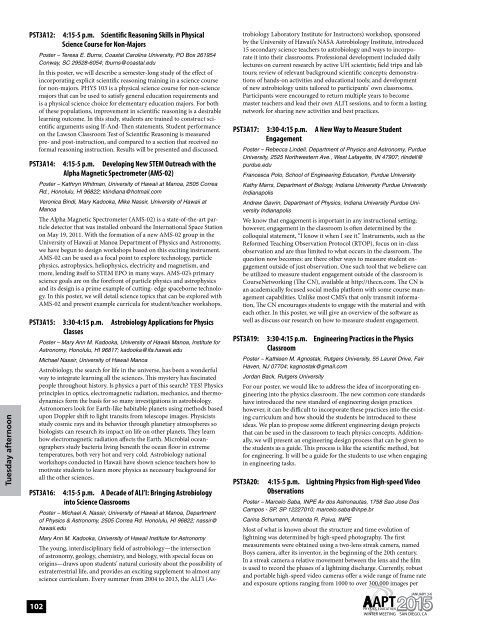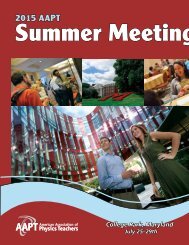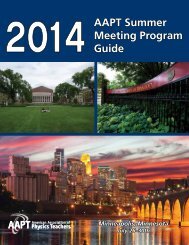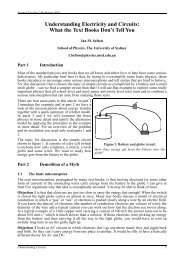final-program-12-23-14-3
final-program-12-23-14-3
final-program-12-23-14-3
You also want an ePaper? Increase the reach of your titles
YUMPU automatically turns print PDFs into web optimized ePapers that Google loves.
Tuesday afternoon<br />
PST3A<strong>12</strong>: 4:15-5 p.m. Scientific Reasoning Skills in Physical<br />
Science Course for Non-Majors<br />
Poster – Teresa E. Burns, Coastal Carolina University, PO Box 261954<br />
Conway, SC 29528-6054; tburns@coastal.edu<br />
In this poster, we will describe a semester-long study of the effect of<br />
incorporating explicit scientific reasoning training in a science course<br />
for non-majors. PHYS 103 is a physical science course for non-science<br />
majors that can be used to satisfy general education requirements and<br />
is a physical science choice for elementary education majors. For both<br />
of these populations, improvement in scientific reasoning is a desirable<br />
learning outcome. In this study, students are trained to construct scientific<br />
arguments using If-And-Then statements. Student performance<br />
on the Lawson Classroom Test of Scientific Reasoning is measured<br />
pre- and post-instruction, and compared to a section that received no<br />
formal reasoning instruction. Results will be presented and discussed.<br />
PST3A<strong>14</strong>: 4:15-5 p.m. Developing New STEM Outreach with the<br />
Alpha Magnetic Spectrometer (AMS-02)<br />
Poster – Kathryn Whitman, University of Hawaii at Manoa, 2505 Correa<br />
Rd., Honolulu, HI 96822; ktindiana@hotmail.com<br />
Veronica Bindi, Mary Kadooka, Mike Nassir, University of Hawaii at<br />
Manoa<br />
The Alpha Magnetic Spectrometer (AMS-02) is a state-of-the-art particle<br />
detector that was installed onboard the International Space Station<br />
on May 19, 2011. With the formation of a new AMS-02 group in the<br />
University of Hawaii at Manoa Department of Physics and Astronomy,<br />
we have begun to design workshops based on this exciting instrument.<br />
AMS-02 can be used as a focal point to explore technology, particle<br />
physics, astrophysics, heliophysics, electricity and magnetism, and<br />
more, lending itself to STEM EPO in many ways. AMS-02’s primary<br />
science goals are on the forefront of particle physics and astrophysics<br />
and its design is a prime example of cutting- edge spaceborne technology.<br />
In this poster, we will detail science topics that can be explored with<br />
AMS-02 and present example curricula for student/teacher workshops.<br />
PST3A15: 3:30-4:15 p.m. Astrobiology Applications for Physics<br />
Classes<br />
Poster – Mary Ann M. Kadooka, University of Hawaii Manoa, Institute for<br />
Astronomy, Honolulu, HI 96817; kadooka@ifa.hawaii.edu<br />
Michael Nassir, University of Hawaii Manoa<br />
Astrobiology, the search for life in the universe, has been a wonderful<br />
way to integrate learning all the sciences. This mystery has fascinated<br />
people throughout history. Is physics a part of this search YES! Physics<br />
principles in optics, electromagnetic radiation, mechanics, and thermodynamics<br />
form the basis for so many investigations in astrobiology.<br />
Astronomers look for Earth-like habitable planets using methods based<br />
upon Doppler shift to light transits from telescope images. Physicists<br />
study cosmic rays and its behavior through planetary atmospheres so<br />
biologists can research its impact on life on other planets. They learn<br />
how electromagnetic radiation affects the Earth. Microbial oceanographers<br />
study bacteria living beneath the ocean floor in extreme<br />
temperatures, both very hot and very cold. Astrobiology national<br />
workshops conducted in Hawaii have shown science teachers how to<br />
motivate students to learn more physics as necessary background for<br />
all the other sciences.<br />
PST3A16: 4:15-5 p.m. A Decade of ALI’I: Bringing Astrobiology<br />
into Science Classrooms<br />
102<br />
Poster – Michael A. Nassir, University of Hawaii at Manoa, Department<br />
of Physics & Astronomy, 2505 Correa Rd. Honolulu, HI 96822; nassir@<br />
hawaii.edu<br />
Mary Ann M. Kadooka, University of Hawaii Institute for Astronomy<br />
The young, interdisciplinary field of astrobiology—the intersection<br />
of astronomy, geology, chemistry, and biology, with special focus on<br />
origins—draws upon students’ natural curiosity about the possibility of<br />
extraterrestrial life, and provides an exciting supplement to almost any<br />
science curriculum. Every summer from 2004 to 2013, the ALI’I (Astrobiology<br />
Laboratory Institute for Instructors) workshop, sponsored<br />
by the University of Hawaii’s NASA Astrobiology Institute, introduced<br />
15 secondary science teachers to astrobiology and ways to incorporate<br />
it into their classrooms. Professional development included daily<br />
lectures on current research by active UH scientists; field trips and lab<br />
tours; review of relevant background scientific concepts; demonstrations<br />
of hands-on activities and educational tools; and development<br />
of new astrobiology units tailored to participants’ own classrooms.<br />
Participants were encouraged to return multiple years to become<br />
master teachers and lead their own ALI’I sessions, and to form a lasting<br />
network for sharing new activities and best practices.<br />
PST3A17: 3:30-4:15 p.m. A New Way to Measure Student<br />
Engagement<br />
Poster – Rebecca Lindell, Department of Physics and Astronomy, Purdue<br />
University, 2525 Northwestern Ave., West Lafayette, IN 47907; rlindell@<br />
purdue.edu<br />
Francesca Polo, School of Engineering Education, Purdue University<br />
Kathy Marrs, Department of Biology, Indiana University Purdue University<br />
Indianapolis<br />
Andrew Gavrin, Department of Physics, Indiana University Purdue University<br />
Indianapolis<br />
We know that engagement is important in any instructional setting;<br />
however, engagement in the classroom is often determined by the<br />
colloquial statement, “I know it when I see it.” Instruments, such as the<br />
Reformed Teaching Observation Protocol (RTOP), focus on in-class<br />
observation and are thus limited to what occurs in the classroom. The<br />
question now becomes: are there other ways to measure student engagement<br />
outside of just observation. One such tool that we believe can<br />
be utilized to measure student engagement outside of the classroom is<br />
CourseNetworking (The CN), available at http://thecn.com. The CN is<br />
an academically focused social media platform with some course management<br />
capabilities. Unlike most CMS’s that only transmit information,<br />
The CN encourages students to engage with the material and with<br />
each other. In this poster, we will give an overview of the software as<br />
well as discuss our research on how to measure student engagement.<br />
PST3A19: 3:30-4:15 p.m. Engineering Practices in the Physics<br />
Classroom<br />
Poster – Kathleen M. Agnostak, Rutgers University, 55 Laurel Drive, Fair<br />
Haven, NJ 07704; kagnostak@gmail.com<br />
Jordan Back, Rutgers University<br />
For our poster, we would like to address the idea of incorporating engineering<br />
into the physics classroom. The new common core standards<br />
have introduced the new standard of engineering design practices<br />
however, it can be difficult to incorporate these practices into the existing<br />
curriculum and how should the students be introduced to these<br />
ideas. We plan to propose some different engineering design projects<br />
that can be used in the classroom to teach physics concepts. Additionally,<br />
we will present an engineering design process that can be given to<br />
the students as a guide. This process is like the scientific method, but<br />
for engineering. It will be a guide for the students to use when engaging<br />
in engineering tasks.<br />
PST3A20: 4:15-5 p.m. Lightning Physics from High-speed Video<br />
Observations<br />
Poster – Marcelo Saba, INPE Av dos Astronautas, 1758 Sao Jose Dos<br />
Campos - SP, SP <strong>12</strong>227010; marcelo.saba@inpe.br<br />
Carina Schumann, Amanda R. Paiva. INPE<br />
Most of what is known about the structure and time evolution of<br />
lightning was determined by high-speed photography. The first<br />
measurements were obtained using a two-lens streak camera, named<br />
Boys camera, after its inventor, in the beginning of the 20th century.<br />
In a streak camera a relative movement between the lens and the film<br />
is used to record the phases of a lightning discharge. Currently, robust<br />
and portable high-speed video cameras offer a wide range of frame rate<br />
and exposure options ranging from 1000 to over 300,000 images per<br />
WINTER MEETING<br />
JANUARY 3-6<br />
2015<br />
SAN DIEGO, CA






